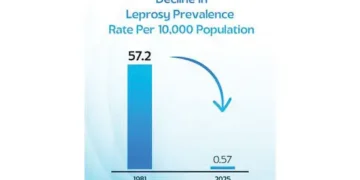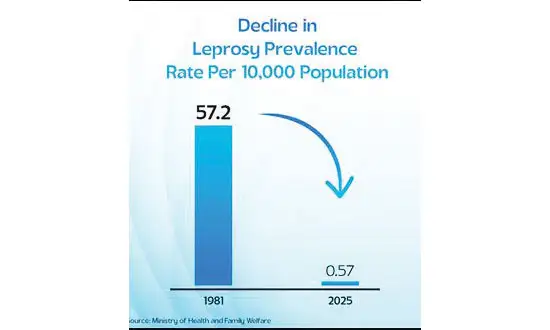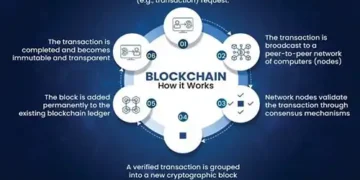Blitz Bureau
NEW DELHI: INDIA’S response under the National Leprosy Eradication Programme (NLEP) includes: free diagnosis; early case detection campaigns; disability prevention, medical rehabilitation (DPMR) and welfare support; capacity building; community awareness to promote voluntary reporting and stop stigma and discrimination; abolishing discriminatory laws; enhanced surveillance and notification; and digitalisation of reporting systems.
Since 2015, constant efforts under NLEP have contributed to significant prevention of disability through early intervention and expanded surveillance mechanisms.
Strategic plan
The NLEP embarked upon developing a new strategy document to accelerate the efforts towards leprosy control and overcome the impact of the Covid pandemic. This strategy is aligned with the Global Leprosy Strategy 2021-2030 and the WHO Roadmap for Neglected Tropical Diseases 2021-2030, aiming to achieve interruption of transmission of leprosy by 2030.
The strategy focuses on interruption of transmission and achieving zero indigenous cases by accelerating case detection activities in high endemic districts and sustaining a strong surveillance system in low endemic districts. Strategies to be adopted are: acceleration of new case detection by targeted approach; Intensified surveillance systems; digitalisation; introduction of advanced tools and techniques for early diagnosis; providing immediate chemoprophylaxis to all contacts of cases forthwith; and introduction of a potential safe and effective vaccine.
Besides, the strategies include introduction of surveillance of anti-microbial resistance and adverse drug reactions; post-treatment surveillance of treated cases; sustain leprosy expertise and move towards multi-disease service integration; improved treatment outcomes by introduction of new treatment regime; and widespread awareness with impactful behavioural change communication methods.
Discriminatory laws
In addition, strengthening existing partnerships, adding more partners and repealing the existing discriminatory laws against leprosy is also required. The implementation of the National Strategic Plan and Roadmap for Leprosy 2023- 2027 aims to achieve interruption of transmission at district level evidenced by zero occurrence of new child cases for at least five consecutive years.
After achieving interruption of transmission, districts shall move on to achieve elimination of leprosy as a disease with zero new cases reported for at least three consecutive years. A follow up of those districts will be done side by side for verification. A ‘whole-of-Government’ and “wholeof-society” approach, along with digital surveillance tools, and strong institutional memory, are being employed for meeting the target.
National Strategic Plan and Roadmap for Leprosy 2023-27: The strategy document and roadmap outline the strategic interventions and lay out a clear-cut roadmap to achieve the goal of interruption in transmission of leprosy by 2027. Contact tracing is done and Post Exposure Prophylaxis (PEP) is administered to the eligible contacts of index case in order to interrupt the chain of transmission.
Leprosy screening has been integrated with the activities of comprehensive primary health care under Ayushman Bharat Yojana for screening of people above 30 years of age.
Leprosy screening has been integrated with Rashtriya Bal Swasthya Karyakram (RBSK) and Rashtriya Kishore Swasthya Karyakram (RKSK) for screening of children (0-18 years). Various services are being provided under the programme for Disability Prevention and Medical Rehabilitation (DPMR) i.e., reaction management, provision of Microcellular Rubber (MCR) footwear, Aids & Appliances, self-care kits etc. (Concluded)
































